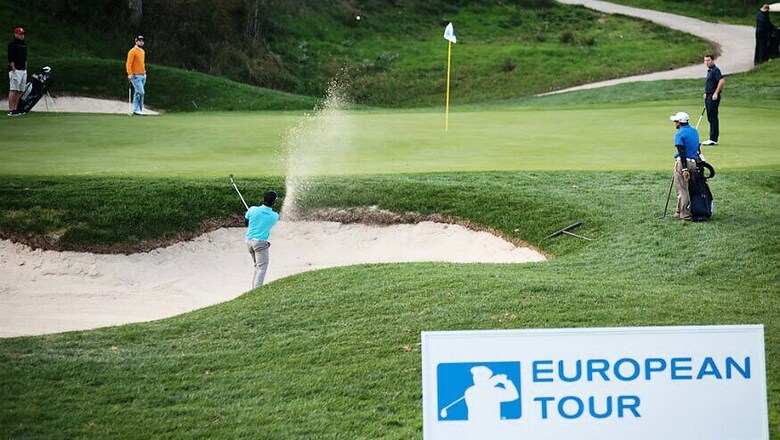
views
In sports, while the epicentre remains the game itself, technology has played key roles in taking different sports on to the era of connected everything. Think of what T20 did to cricket, and how technologies like UltraEdge, HotSpot and ball tracking altered the sport. The same applies for football, with the much contentious Video Assistant Referee (VAR) bringing in always-connected cameras, positioning and augmented reality (AR) to fundamentally transform key aspects of the sport.
However, when you talk about golf, technology may not quite be the first thing that comes to mind. Yet, quite on the contrary of what it may seem like, the entire landscape of golf is leaning heavily on new technologies to bring forth fundamental changes in the way the sport is viewed, transmitted, packaged, laid out and even played. Naturally, the whole portfolio of new technologies, including 5G, artificial intelligence (AI), virtual reality (VR), the internet of things (IoT), data analytics and more, have all lined up in a bid to make golf more engaging, and above all, more connected.
Connecting courses
Smartening up the sport begins with what is unsurprisingly called the “connected” course, states Michael Cole, chief technology officer of the Professional Golfers’ Association’s The European Tour. For reference, the PGA European Tour is one of the world’s leading golfing bodies, being the primary golfing tour of Europe.
As Cole explains, “If we take conventional tournaments, I’m deploying up to five infrastructures for each tournament. There will be one for public Wi-Fi, one for broadcast, one for operational tasks, one for scorers, and a fifth for tournament TV (the big screens across the course). For each tournament, we’d be deploying anywhere between 100 to 700 wireless access points to create the concept of the connected golf course.
“This is all about providing accessibility to applications and internet services, be it for a spectator, a player, a journalist or anyone. We concentrate these access points in specific areas, like a grand stand on the 18th, to the pavilion or in the media centres. When one considers these five infrastructures, we may have anywhere between 30 and 150 cameras around the course for broadcasters. We further have our own production unit as well, and that is where Tata Communications help us — in terms of distribution via 43 rights holders, out to 150 countries worldwide.”
Using 5G as a foundation
Unsurprisingly, Cole opines that much of these operations are in process of being streamlined in the future, owing to the advent of 5G. With this being yet another area of 5G’s industrial application, the benefits for the sport of golf seems apparent to a body like the PGA European Tour. Touching upon this, Cole says, “One of my aims in terms of the concept of the connected course is to converge and collapse the five different infrastructures into one. The ability to utilise 5G in a local environment, to be able to create the accessibility in a far more efficient way — in terms of less fiber, less people, less deployment time and near-ubiquity in terms of the level of access, be it across mobile or wireless infrastructure, will become critical in the near future.”
The scale of benefits is quite clear for golfing bodies, since these are not only indicative of the bottom line impact of the sport or the event, but also have a clear effect on how infrastructure is managed. As Cole elucidates, “For every tournament, we deploy up to 200 kilometres of fiber network. With 5G, less fiber needs to be deployed, which automatically makes for advantages. It would take us anywhere up to six weeks to deliver such infrastructure right now for a typical, high profile event like the Ryder Cup. For smaller tournaments, it takes up to two weeks. With 5G, deployment time would be far lesser. Today, it takes anywhere between six and 16 people to deploy the connectivity infrastructure, which automatically reduces with 5G. It also provides more flexibility around the course since cameras do not need to be hard-wired.”
Engaging the hyper-connected millennials
Connecting the sport of golf to young viewers is particularly important, once the connected course is set up and the 5G infrastructure is ready to roll. As a result, it has become increasingly important for Cole to use the benefits of technology, to drive engagement. As he explains, “Some of our needs from technology lie around spectator engagement, and broadcast and media tech, to make things more immersive. To test this, we have trialled VR in our tournaments with Tata Communications, with our British Masters event in UK in 2018.
“These technologies give us the ability to create the content that is unique, and is in demand. Part of these ideas is part of a mobile first strategy in golf — we recognise that the audience is wishing to consume content more on phones, and do so collectively. Using these may help in direct objectives such as top line growth in revenue, as well as bottom line benefits in reducing costs.”
Tracking players, viewers and data
With engagement out of the way, the next clear element that makes one curious is the use of IoT wearables and other such connected hardware in the sport, to improve the game, the players and more. This is where the deployment of IoT in golf comes in. Ask Cole, however, and he states that the use of IoT in the sport is not as straightforward as snapping wearables on the players to improve their game. In fact, the biggest impact of IoT in golf is expanding the volume of data that the PGA European Tour can process, in order to improve various facets of the game.
Cole explains, “Our typical data collection leads to 20,000 data points approximately, collected per tournament. From January 2020, we will be collecting 15 data points for every player, on every stroke, in real time. That equates to up to 700,000 data points in every tournament. So, collecting data through cloud analytics and player performance is providing a significant opportunity. Data, in essence, will become the new currency for us.”
As for tracking players and personal-level connected gadgets, Cole believes it has an extrapolated role to play, beyond just tracking individual playing styles. “The biometrics and wearables for the players will come, but we don’t believe that the time is right as yet, since there are too many rules and policies governing the use of technology by players at a professional level. My approach is to look at areas where we can deploy IoT right away. For instance, pace of play is a big challenge for golf — the amount of time that players take to move around a course is quite high. We are already deploying IoT capabilities, to be able to track the players and monitor their time against a schedule, and use that insight to help evaluate the player groups that are out of position, or even in position. We can then use these to intervene and quicken up that pace,” he says.
Tracking the generated data is further helping monetise golf, and manage spectators on a golf course. As Cole highlights, “At the 2018 Ryder Cup, we tracked 100,000 devices moving across the course, and understood their behaviours to deliver critical insights operationally. This enabled us to really identify where the crowd was, and create geofencing to understand when crowds are moving into particular zones. This particularly helps our marketing and commercial partners. For instance, a spectator entering a geo-zone can produce a trigger on our end, and activate a notification that can redirect a person to the food and beverages section in the course, or head to the merchandising zone to buy products and services.”
Building a technology incubator
To procure all the above mentioned technologies, Cole states that the PGA European Tour now has its own innovation hub. An incubation platform of sorts designed for purpose-built innovation, the Tour’s innovation hub draws attraction from companies, individuals, startups and entrepreneurs alike to build technological solutions. Cole further highlights how there is not a single, unified golfing body holding the entire world’s tournaments together, and believes that this is a bigger reason why there is a need for building connected and relevant technologies that can improve the sport.
Interestingly, Cole believes that this is where India fits in, too. “We see benefits in India not just as a golfing community, but as a centre for technological innovation. It is a potential centre for entrepreneurship, and I’ve already received multiple requests of interest in the innovation hub from various parties in India,” says Cole. While he does acknowledge that India as a golfing community is still far from mature, he sees a role in which Indian startups and entrepreneurs are participating in the sport as well.




















Comments
0 comment